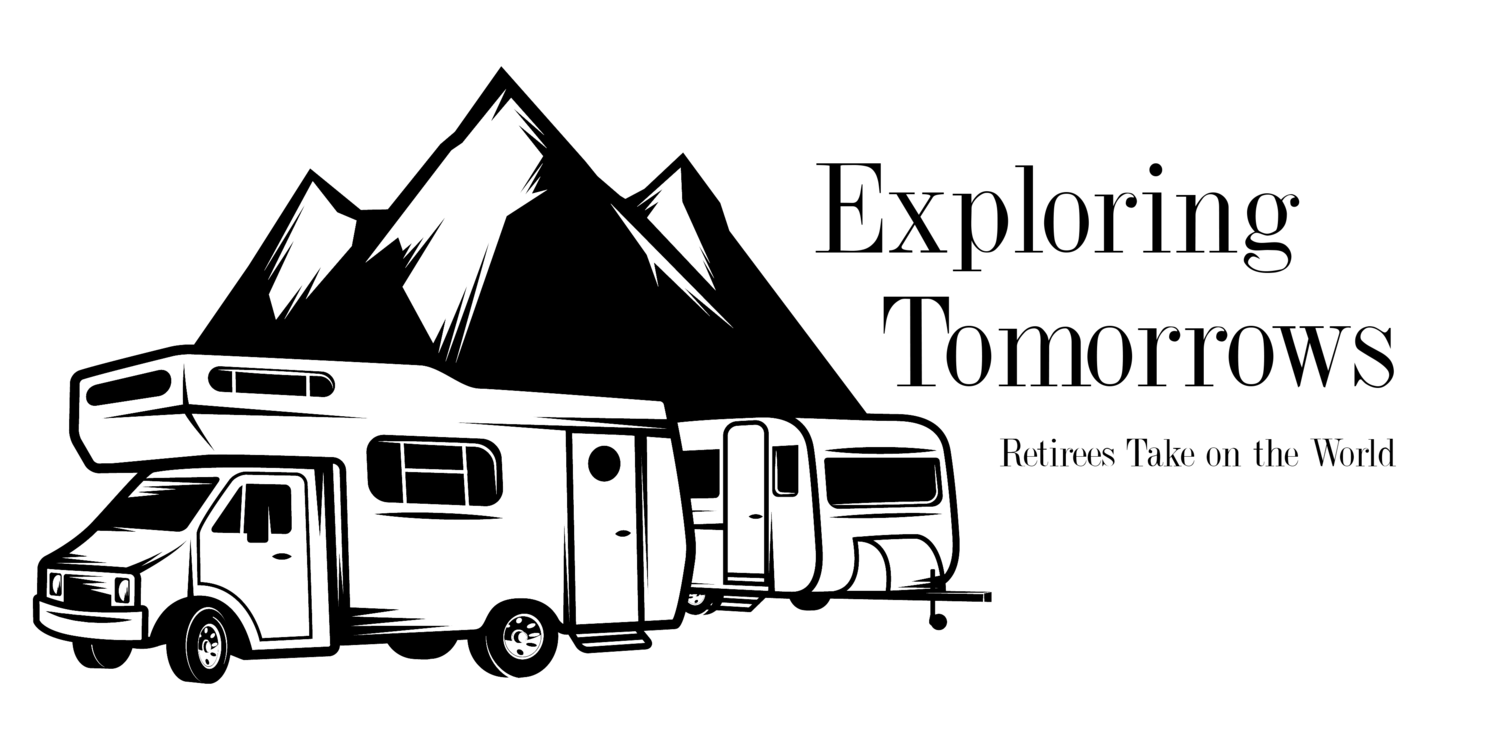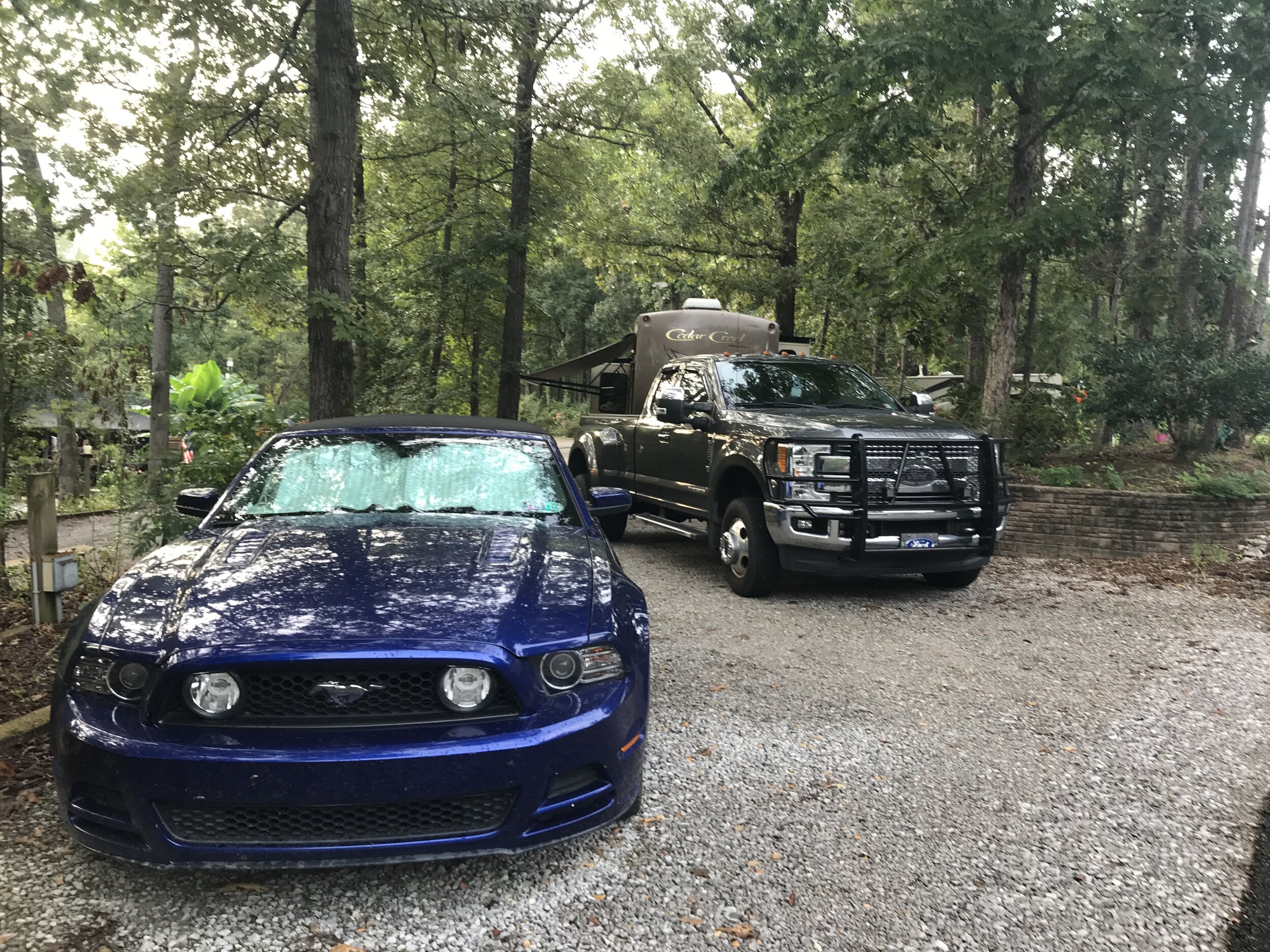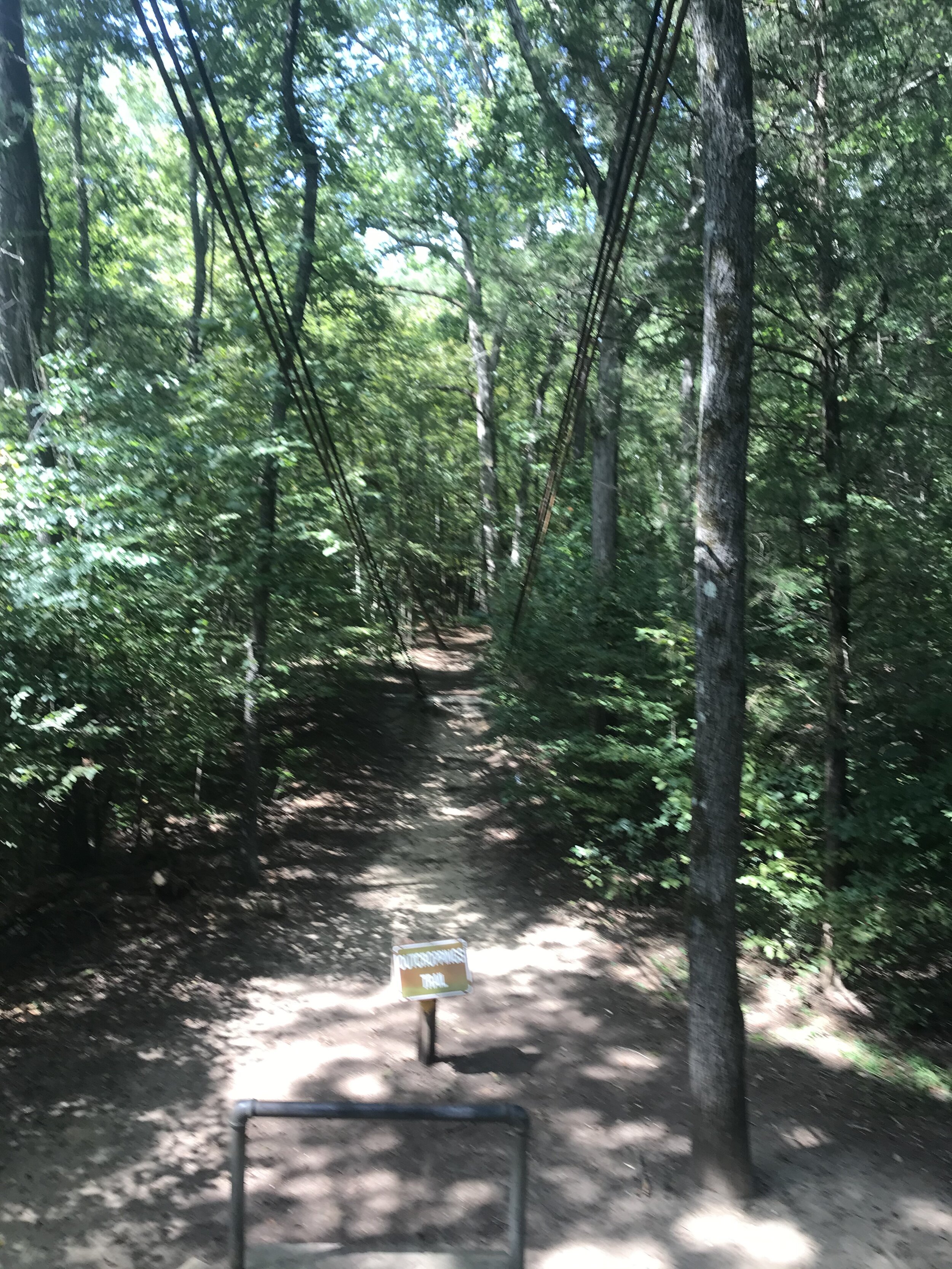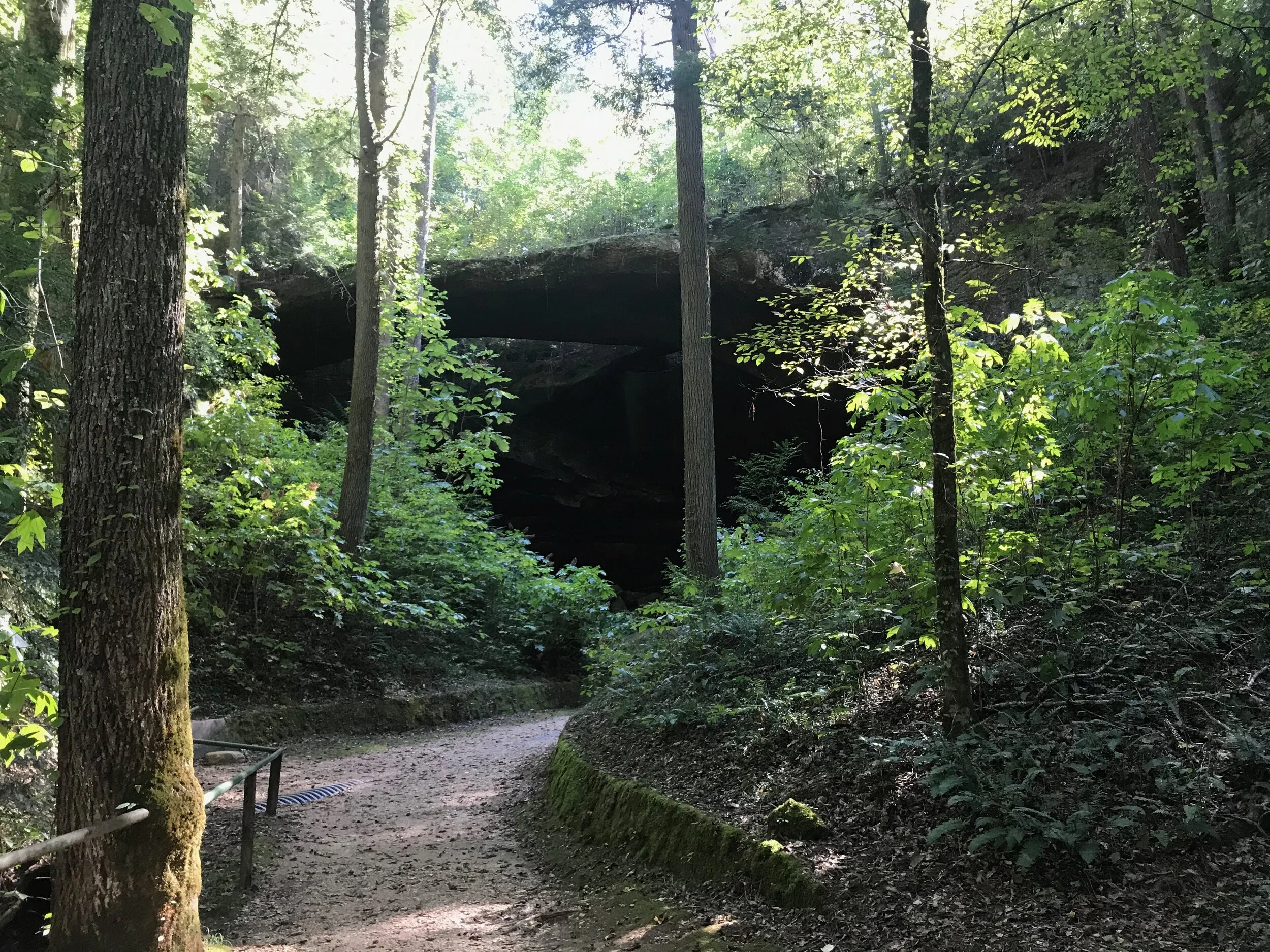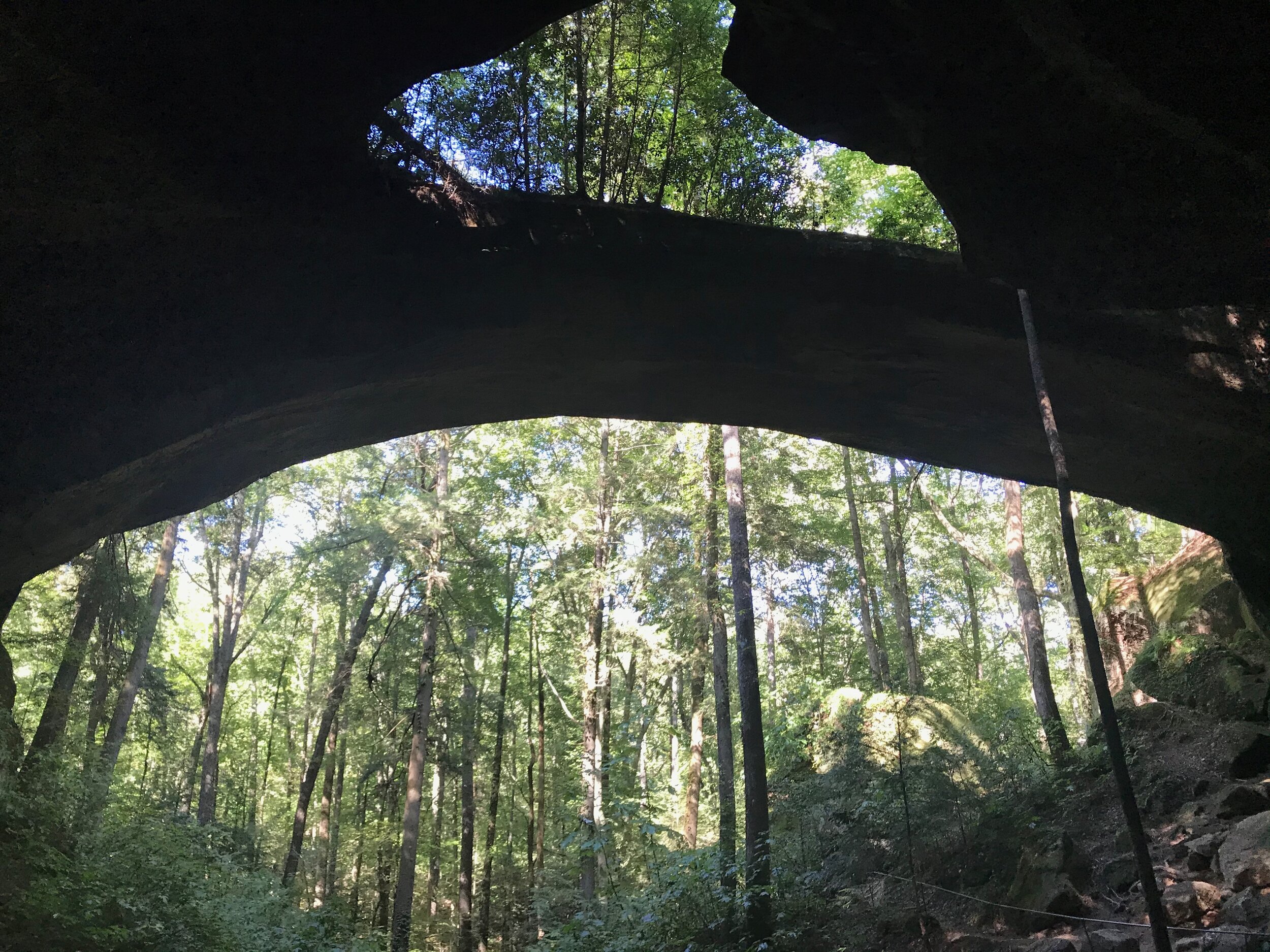Checking the Rear View: Lessons Learned in Our First Year of Full Time RV Living
/Well it is official! We have been full time RVers for one year. It seems like just yesterday I was still working and going to an office every day. Now we are living the life that we planned and enjoy traveling the country. Tim and I talked about what date we should use as our full time anniversary date. My last official work day was September 20, 2019, and technically I was working from the RV for the last two weeks. Since we stayed in Pittsburgh for some of those two weeks and were still moving some of our stuff from there to the camper, we decided to use my last work day as our official full time anniversary date. We stayed in that campground until October 8, 2019, then we started traveling, so Pennsylvania was the first state that I put on our map.
Our travel map.
We bought a map with stickers for each state that we are using to track our travels. In our first year, we have visited thirteen states, a few of them twice. As you can see from the picture of our map, we have only stayed east of the Mississippi, and from Pennsylvania, south to Florida. We want to go further west and we will eventually get there, hopefully. I have to say that the first year on the road has been a learning experience for us. For the past fifteen years, we have primarily had our RV parked at a seasonal site in a campground. When we left, it was the first time that we had traveled pulling the fifth wheel. So even though we have more twenty years experience as RV owners, we were like newbies, learning as we traveled.
The first lesson that we learned was to go slow and take our time in each place. When we first started out, we were in vacation mode and tried to see everything that we could in each area that we stopped. I would get frustrated because we couldn’t fit everything in, especially if we were only staying for a week. While that was fun, the pace was a bit too hectic for both of us. Tim isn’t as much into touring as I am so he doesn’t care if we miss out on somethings, but he likes to have more time to relax at each site. Travel days are hectic and stressful for him.
So we discovered that for us, stopping and staying longer in each place works out better. We are now trying to stay a least two weeks at many of our stops and some times staying for a month or longer. We have also decided that we will do a seasonal site for the winter so we are only traveling about eight months of the year. It will take us longer to see the lower 48 states, but we will enjoy it more, so it is worth it.
There is so much to see in this vast country and it is amazing how much there is to do in each state. Now we pick a few top things that we want to do in each area, focus on those so we can also spend time at the RV Park or campground. That gives us more time to relax and enjoy meeting our neighbors and fellow RVers; “Stopping to Smell the Roses”, so to speak.
Lesson two is similar to lesson one and is the same theme: “go slow”. Since we hadn’t towed the fifth wheel before, we had to learn the steps needed to prepare for towing and setting it up. One thing that we did not do initially was make a list of the steps needed to assure we can travel safely. Both of us do fairly well with mental checklists but those failed us a few times. Luckily none were too costly even if we did cause a little damage. Typically we learn from mistakes and use caution to not repeat them but that has failed us a few times too.
For example, when we hooked up the fifth wheel to leave initially, Tim backed up with the tailgate down. We weren’t sure if we could complete the connection without putting the tailgate up so it wouldn’t hit the RV. He backed up close and we put tailgate up and he started to complete backing in to connect to the hitch. I guess he wasn’t aligned correctly so he just changed and started to pull back forward a bit and forgot the tailgate was up. I didn’t notice either and he started pulling forward and the hitch caught on the tailgate. I screamed to stop and luckily he was able to stop in time before there was too much damage to tailgate. We were careful after that but a few months later, we were hurrying during the disconnect and he forgot to put the tailgate down before pulling forward. There are now a few scratches and gouges in the top of the tailgate which is not good but at least it still works fine.
We have seen people pull out of their site dragging their electrical connection and wire down the driveway of the campground because they forgot to unplug. Fortunately we stopped them before they started dragging it down the driveway. Another couple forgot to lower their satellite dish which definitely added to the height of their rig.
We definitely need to relax and slowdown to avoid mistakes. We have created a checklist and while we are not yet consistent in using it, we have been doing much better slowing down and focusing on the tasks at hand when getting ready to tow and when disconnecting and setting up in a site. Go slow and being methodical to assure you take all of the correct steps is key to success. We need to pull out the checklist and double check that we have done all of the necessary steps before we leave or fully disconnect. Tim also walks around at every stop, doubling checking the hitch connection and tires.
A typical site after getting set up
Lesson 3: Living in an RV doesn’t change day to day life. It is true that you get to wake up in different locations with changing scenery and live somewhat in vacation mode. You also have the same day to day life chores that you have no matter where you live, like cooking, cleaning, laundry, and maintenance. RV maintenance is one thing that takes up a bit of our time. There is always work to do on an RV. They say that when you travel down the road, it is like an earthquake happening to your RV. I can’t tell you how true that is. Even though we close everything up properly, we have had stuff move that shouldn’t have while we were traveling. Once we found the refrigerator had tipped forward, the doors opened and stuff spilled out onto the floor. It turned out that the bracket holding the refrigerator in place had loosened up a little which caused it to tip and open. Checking and tightening that before traveling is now on our check list. Tim also made a better device to hold the doors closed.
It seems that every time we open up after parking in a new location, I find little screws on the floor that came out from somewhere but often we can’t figure out from where. We have had pieces of trim come loose, weather stripping on the slides tear, and one of the window valances fall down. Needless to say, there is always maintenance and repair work that needs to be done. Even with these things going wrong, we are enjoying this lifestyle. When we had a home, there was always a to do list as well. It is just that now we have to take steps to do some of the maintenance at every stop to make sure we can travel safely and not find things damaged at the next stop. Some of our routine maintenance steps included lubricating the stabilizing jacks, slide gears and gaskets; checking the tires and air pressure; and making sure everything inside is secured in place. We are tired before we even start traveling. Neither of us are fond of travel days because of this.
The fourth lesson is that this lifestyle can cost more than you expect. We started with an anticipated budget in mind and quickly found that sticking to it was challenging. Of course, neither Tim or I have ever been rigid about sticking to a budget. We have managed our money and saved for our future, but we did that without having a written budget that we followed. We never tracked our expenses before but we were successful at living within our means and keeping our debt manageable. Without a bi-weekly pay check, we decided that we should track all of our expenses and set a monthly budget when I retired.
Tim suggested that we set our monthly budget at $5000 or $60,000 per year. That would be for all of our expenses. Healthcare costs suddenly became a large number since I am still too young for medicare. I thought we could live on less than that and know others that do. Campgrounds and RV parks are another one of the highest expenses for this lifestyle. I would like to stay in more state and national parks to be more in nature but we really like full hook up so it is a trade off. At some point we may boondock more to reduce costs but we are not really set up for that yet. So we set the budget a bit higher to accommodate the way that we are traveling.
Tim felt that our monthly budget should be $1000 for campgrounds. My goal was to average $30 per night. Overall, we came in under budget for campgrounds averaging $26.20 per night and $797 per month. We had some months in the beginning that were much higher and we have been really focusing on keeping our campground costs down in more recent months which has helped tremendously. Staying in one place longer to get lower monthly rates really helped. Another thing that helped our campground costs was joining Thousand Trails. We have focused on using it recently which is saving us quite a bit of money.
We still were over the annual budget though, mostly due to some larger unplanned expenses. When we first started traveling, we acted like we were on vacation, touring and eating out quite a bit. That certainly increased our expenses initially. Then we bought a car in May which wasn’t in the budget and we had a few other repair costs that we didn’t plan for. Without the car, we would have still been over budget with our total expenses for the year coming in at $66,000. Overall, that isn’t too bad and I think we will do much better in our second year. We are definitely eating at home much more and finding less costly or free entertainment.
I guess the fifth and last lesson is that is if you want to live in an RV, you better really like the person you are living with. We are fortunate that we love each other and like spending time together. Even so, there are challenges. While we have a good sized fifth wheel, it is definitely a much smaller living space than we were used to. We prepared for it by downsizing to apartments the 2 years before moving into the RV. This was still a big jump and it took us a little while to adjust to be in each other’s space so much. When I was working, Tim got used to being home by himself and having autonomy during his day. I had freedom and independence at work and at home. It took a little while to adjust to being together 24/7 and we have learned that we need to give each other space at times during the day.
The one great thing about the RV lifestyle is that we can plan our trips to always be in warmer weather where we can spend time outside. I love walking and being in nature so my alone time is usually taking walks or hikes in beautiful settings. I also enjoy sitting in the sunshine reading. Tim likes to work on the RV and he always seems to be adding to the list of projects that he wants to do. He also reads and spends time researching for his projects online. He also enjoys nature and walking so he joins me at times for hikes.
Hiking trail
It has been an interesting year for sure and so far, we are very happy with this lifestyle. Yesterday Tim suggested a drive to a natural bridge which wasn’t too far away. It was a beautiful sunny day with a gentle breeze and a high in the 70’s. The natural bridge in Alabama is the largest one east of the Mississippi so it was definitely worth seeing. It is wonderful to follow a whim and just take off for an afternoon to just enjoy the scenery. I will cover more on our stay here in northern Alabama in the next blog post so look for that in the near future.
The Natural Bridge
The view from underneath the natural bridge
